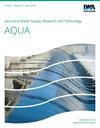湘江流域城市水质驱动力定量溯源研究
IF 4.3
Q2 Environmental Science
引用次数: 0
摘要
基于湘江流域16个水质监测站1990 - 2020年的月度监测数据,采用Mann-Kendall检验法分析了溶解氧、5天生化需氧量、高锰酸盐指数、总磷、氨氮、镉、砷和六价铬。采用逐步回归法等9个指标的变化趋势确定各水质指标的跨城市驱动力,并通过主成分分析得到各驱动力的贡献率(权重)。研究结果表明:(1)农业是永州经济增长的主要驱动力,贡献率为67.2%;(2)城市化对湘江流域水环境驱动过程的影响较大,贡献率为:长沙(83%)>衡阳(80.7%)>萍乡(63.7%)>郴州(60.9%)>湘潭(57.4%)>株洲(50%)>娄底(48.5%);(3)株洲市和娄底市的城市化不仅对城市水环境产生影响,还带动了下游湘潭地区的水环境。研究成果可为流域水环境治理研究提供依据和参考。本文章由计算机程序翻译,如有差异,请以英文原文为准。
Quantitative traceability study on the water quality driving forces across cities in the Xiang River Basin
Based on the monthly monitoring data of 16 water quality monitoring stations in the Xiang River Basin from 1990 to 2020, the Mann–Kendall test was used to analyze dissolved oxygen, 5-day biochemical oxygen demand, permanganate index, total phosphorus, ammonia nitrogen, cadmium, arsenic, and hexavalent chromium. The changing trend of nine indicators, including the stepwise regression method, was used to determine the cross city driving force of each water quality index, and the contribution rate (weight) of each driving force was obtained by principal component analysis. The research results show that (1) agriculture in Yongzhou is the main driving force, and its contribution rate is 67.2%; (2) urbanization has a greater impact on the driving process of the water environment in the Xiang River Basin, and its contribution rate is as follows: Changsha (83%) > Hengyang (80.7%) > Pingxiang (63.7%) > Chenzhou (60.9%) > Xiangtan (57.4%) > Zhuzhou (50%) > Loudi (48.5%); (3) the urbanization of Zhuzhou City and Loudi City's urban sewage discharge not only has an impact on the city's water environment, but also drives the water environment in the downstream Xiangtan area. The research results can provide a basis and reference for the study of water environmental governance in the basin.
求助全文
通过发布文献求助,成功后即可免费获取论文全文。
去求助
来源期刊
CiteScore
4.70
自引率
0.00%
发文量
74
审稿时长
4.5 months
期刊介绍:
Journal of Water Supply: Research and Technology - Aqua publishes peer-reviewed scientific & technical, review, and practical/ operational papers dealing with research and development in water supply technology and management, including economics, training and public relations on a national and international level.

 求助内容:
求助内容: 应助结果提醒方式:
应助结果提醒方式:


